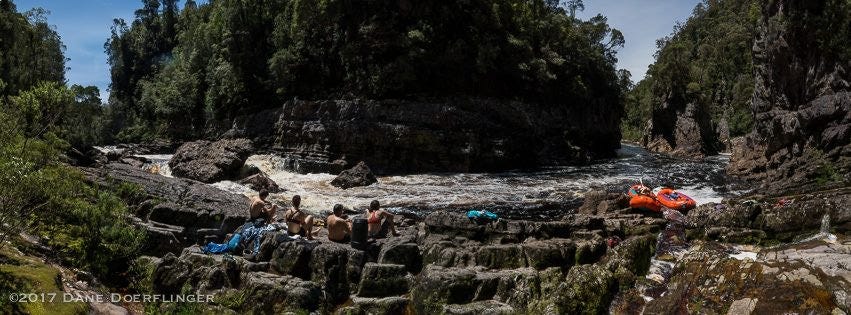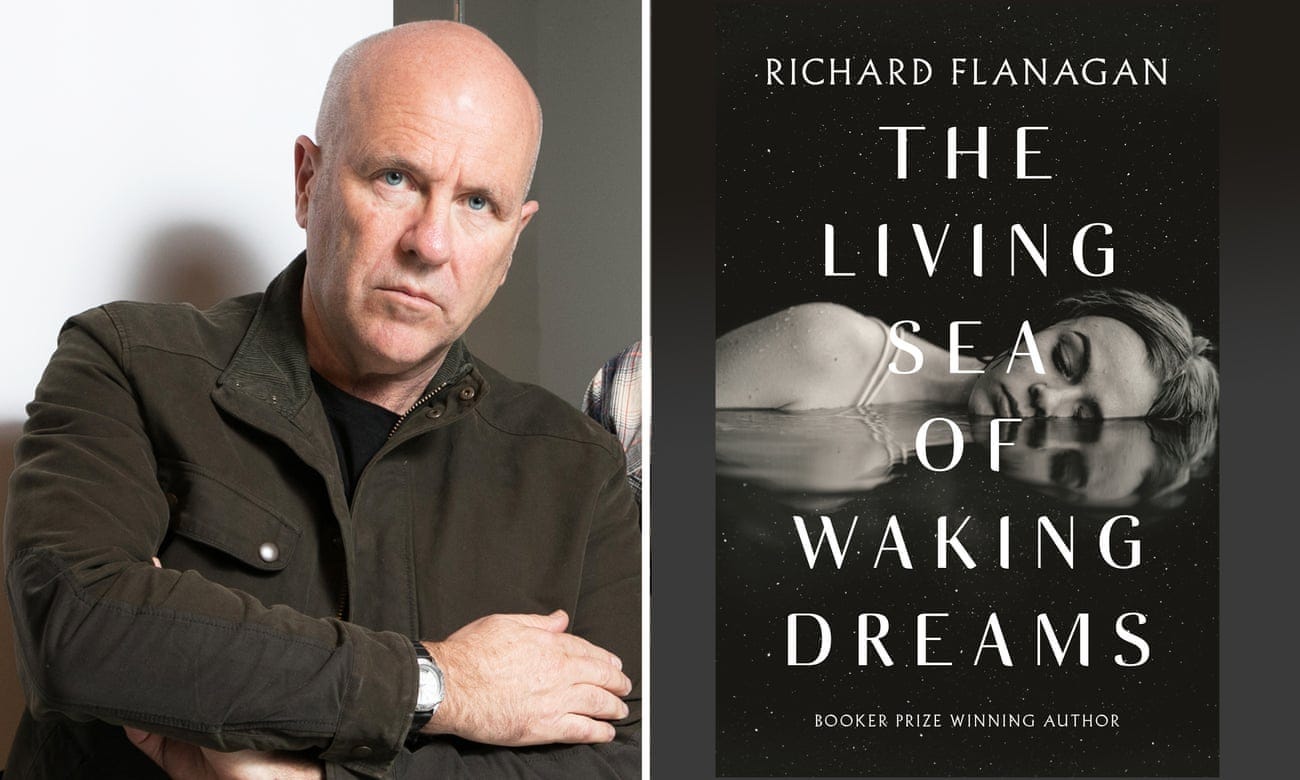The Ever Varying Flood - Part VIII
"Fortune presents gifts not according to the books. . ." - Dead Can Dance

Dane Doerflinger’s excellent panoramic photo of the site on the Franklin River where a dam had been planned in the 1970’s.
THE EVER VARYING FLOOD
In December of 2017, seven of us ventured Down Under to boat a river only one of us had ever heard of before this trip was planned. This is our story.
I read about the Franklin River more than forty years prior to our trip in December of 2017. It was a National Geographic article about the massive protests that stopped the proposed dam and created a World Heritage Park that first caught both my attention and imagination.
For reasons unknown to me, I had always dreamed of traveling to Australia. Even more bizarre, in my youth, I was fascinated with the idea of Perth. I must have been drawn to its remoteness.
I’ve been writing a story for several decades. My working title was Death of a River Guide. I toyed with setting it in Australia or Peru. I was undecided and I viewed my adventures to both countries as research.
Imagine my surprise when my brother called me around the turn of this century to tell me he had just listened to an NPR story about an Australian author who had written a book titled Death of a River Guide! I shrugged it off because he told me it had been written by a guy who was a guide in Australia. I’d read a good deal of river running literature and most of it was insipid or hokey and, usually, poorly written.
So, I didn’t follow up on the NPR story and my brother hadn’t listened closely enough to fill in very many details.
Imagine my surprise to learn the author of that book was on the Franklin River at the very same time I was! And that he was approximately my age, had been a Franklin River guide, spent hours with his foot entrapped in the Descension Gorge believing he was going to drown and is considered one of Australia’s preeminent writers!
Fortune smiled on our group throughout this adventure.
One of our members met someone in Peru who lived in Hobart, kayaked the Franklin more than once and was gracious enough to invite us to dinner prior to our trip, show a slideshow depicting all of the rapids, laminate maps we could take, offer advice and loan us large bicycle tubes we were meant to use as portable toilets.
The University of Tasmania whitewater club allowed us to join their club for a mere pittance and then rented small rafts, and other gear, to us for an additional pittance.
The river spiked dramatically a day before our launch after torrential downpours all across the island. mellowed out upon our arrival and then rose only high enough to make everything just a tad bit simpler. We had no torrential downpours while we were on the river.
And then, at one of our first camps, we meet an all star party of guides with tree-hugging, scientist guests from all over the world, and Richard Flanagan, esteemed Australian author of Death of a River Guide.
What were the odds?
Earlier today I was thinking about the lead up to this grand adventure. The anticipation and the research and I was remembering going over the maps again and again and wondering how it would all play out when we actually got there. I remember wondering about the sailboat that would meet us at this random place in the wilderness of Tasmania to take us back to a grizzled fishing and tourist town on the rugged west coast. How would that all work out? How would the timing work?
It was a bit of a leap into the unknown. It requires an act of faith that things will work out.
That’s the beauty of adventures and trips. You have the anticipation, the adventure itself and then the retelling. It’s not the adventure alone. Sometimes they resonate for years.
I remember emerging from The Great Ravine and feeling as if I could breathe freely again. It was not as if there was no more whitewater, or no more compulsory portages, it was that we were no longer hemmed into a gorge at the mercy of the elements. In fact, we encountered at least four more portages. The scariest one being Pig Trough which is in the picture above and located immediately upstream of Rock Island Bend.
As we approached the confluence of the Gordon River, it seemed as if the original explorers had grown weary of coming up with delightful, fanciful and whimsical names - like Ganymedes Pool, Irenabyss and Nasty Notch. The rapids toward the end were called Little Fall, Double Fall and Big Fall.
Our kayaker friend in Hobart warned us of how deceptive Big Fall could be and sternly advised us not to be lured into challenging it. She said, though it appears to be a single, simple eight foot fall, something about the contours of the rocks causes the backwash to be more powerful than you might think, and ‘stickier’ than you might think.
As it turned out, it was the closest we came to tragedy on the trip and it was the last whitewater we would see.
One of our rafts opted to run it, missed their intended line by a hair, lost a paddler overboard, the raft got wrenched broadside under the fall and into the clasp of the recirculating water and, if not for the swimmer grabbing the perimeter line as he was being sucked under the caught raft, and the remaining paddler catching a well-thrown and well-timed rescue line, there might have been a sadder tale to tell.
After Big Fall the river was as flat as a two lane blacktop.
We reached the Gordon River thinking the final twenty kilometres to our rendezvous site at Sir John Falls would be an uneventful endeavor. But what our Franklin River guide friends had failed to mention and what none of us had paid attention to when reading the description of the landing on the Gordon River was that the Gordon was influenced by tides. We knew there could be winds, but we had not counted on there being a tide against us.
It was a double whammy for us. We had upstream winds, while a tide was coming in.
It was the most miserable several hours of paddling I have ever experienced. And I’ve experienced canyon winds that go on for days or are powerful enough to blow you to shore. The humorous thing was - we were unaware of the tidal factor. We thought we were just fighting the wind.
Our Tasmanian friends cruised in later - after the winds had died and the tide was going out.
The next day both groups boarded the yacht slash sailboat for the six hour excursion back to civilization. Eventually, I took the opportunity to chat with Richard Flanagan. I found my opening to talk with him when I heard him mumbling to himself about politics while perusing one of the Aussie Rupert Murdoch rags the skipper had brought along to reintroduce us to the goings on in the world. American politics in particular.
We talked about the state of the world.
He and I didn’t talk about writing and, because I hadn’t yet read anything of his, I certainly didn’t mention the coincidence of my working title and his acclaimed book, or even that I liked to write.
I had no idea whether I would even like his book. But I could tell by speaking with him that he was passionate about history, river running, the environment and human rights. And he loathed our president as much as I did.
Right then and there, I decided to read everything he’d written. I have not been disappointed.
###
I was wrong. I have not read everything he has written because he has a new novel just out. It’s his eighth novel. It’s called The Living Sea of Waking Dreams.

And here’s a complete list of his work.
Also, if you have not seen a video of AAR Steve Laboff’s rescue dog, River, you are missing out on the earthly manifestation of “joy”.

Sorry. You have to have a certain type of social media account to watch.
Only two more sleeps. We got this. - JLM



